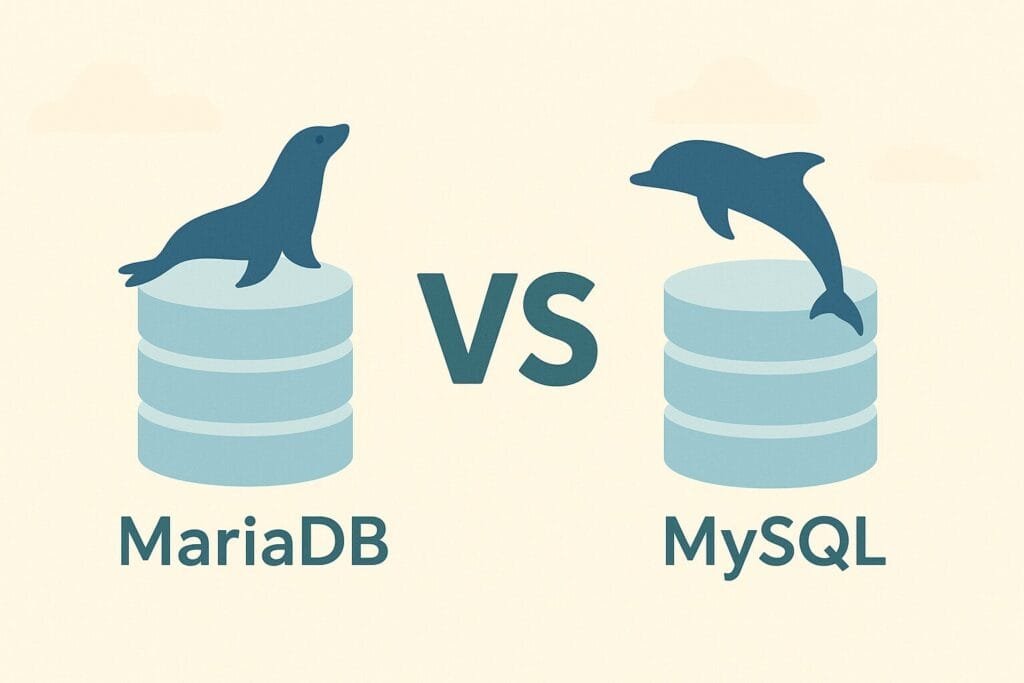When it comes to relational database management systems (RDBMS), MariaDB vs MySQL is one of the most common comparisons among developers, database administrators, and business owners. Both databases are highly reliable, widely used, and open-source. However, there are key differences in performance, licensing, features, and community support that can make one a better choice depending on your project requirements.
In this article, we will break down the major differences between MariaDB and MySQL, provide a detailed comparison table, and help you decide which database system fits your needs best.

What is MySQL?
MySQL is one of the world’s most popular open-source relational database management systems, initially released in 1995. It is currently owned by Oracle Corporation and powers some of the largest websites and applications worldwide, including Facebook, Twitter, and YouTube. MySQL is known for its stability, scalability, and strong ecosystem. It supports multiple storage engines and offers commercial licensing options for enterprise use.
What is MariaDB?
MariaDB is a fork of MySQL, created in 2009 by the original developers of MySQL after concerns about Oracle’s acquisition. It was designed to remain free and open-source under the MariaDB Foundation. MariaDB has since grown into a robust database system, often considered a drop-in replacement for MySQL with additional features, better performance, and enhanced security.
MariaDB vs MySQL: Key Differences
Although MariaDB and MySQL share a common origin, they have diverged in terms of features and development focus. Below is a comparison table to highlight the most important differences:
| Feature | MariaDB | MySQL |
|---|---|---|
| License | GPL v2 (Fully Open-Source) | Dual license: GPL v2 and Proprietary (Oracle) |
| Community Support | Led by MariaDB Foundation, active open-source community | Primarily developed by Oracle, with community input |
| Performance | Generally faster in complex queries and replication | Stable but slightly slower in replication-heavy workloads |
| Storage Engines | Includes Aria, ColumnStore, MyRocks, and others | InnoDB, MyISAM (limited support) |
| Compatibility | Highly compatible with MySQL, drop-in replacement | Widely supported across tools and applications |
| Replication | Supports multi-source and parallel replication | Traditional replication with limited parallelism |
| JSON Support | Uses dynamic columns and virtual columns for JSON | Native JSON support with built-in functions |
| Enterprise Features | All open-source, enterprise features included | Some enterprise features require a paid license |
Advantages of MariaDB
- Open-Source Freedom: 100% open-source with no hidden enterprise-only features.
- Better Performance: Optimized query execution, replication, and thread management.
- More Storage Engines: Flexibility with multiple storage engines beyond InnoDB.
- Community Driven: Strong focus on transparency and community contributions.
Advantages of MySQL
- Proven Stability: Decades of stability and reliability in production environments.
- Wider Ecosystem: Supported by most hosting providers, tools, and applications.
- Commercial Support: Enterprise features and support directly from Oracle.
- Native JSON: Built-in functions make handling JSON data straightforward.
When Should You Choose MariaDB?
MariaDB is the right choice if you want a fully open-source solution with active community development. It is also recommended for projects that demand advanced replication, flexibility with multiple storage engines, or better performance optimization. Startups and businesses that prefer cost efficiency without enterprise licensing fees will benefit from MariaDB.
When Should You Choose MySQL?
MySQL is ideal for enterprises or businesses that require commercial support, guaranteed long-term stability, and integration with Oracle’s ecosystem. If your existing infrastructure already relies heavily on MySQL or enterprise-only features, then MySQL might be the safer choice.
MariaDB vs MySQL: Final Thoughts
Both MariaDB and MySQL are excellent database management systems with their strengths and weaknesses. If you value open-source freedom, performance, and flexibility, then MariaDB is your best pick. On the other hand, if you need enterprise-level support, proven reliability, and compatibility with Oracle products, MySQL is the safer choice.
Ultimately, the decision depends on your project requirements, budget, and scalability goals. Whichever you choose, both databases provide a solid foundation for your applications and services.

